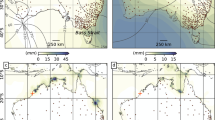Abstract
The oceanic gravimetric effect is calculated by expanding the cotidal maps of the FES2014 oceanic tide model into spherical functions with the use of load Love numbers from the work (Spiridonov and Vinogradova, 2017). The calculation results for the amplitudes and phases of the oceanic gravimetric effect for eight main tidal waves (Q1, O1, P1, K1, N2, M2, S2, and K2) at nine European gravity observation stations of the Global Geodynamic Project (GGP) network are presented. The amplitude delta factors and phase shifts of these tidal waves for the Earth with the ocean are predicted and compared with observations. The difference vectors (prediction minus observations) are analyzed in detail with the use of both different theoretical tide models and oceanic-effect calculation versions. The FES2014 model is included in the ATLANTIDA3.1 tidal prediction software. The results of the work show, first, that the FES2014 is one of the best oceanic models today. The amplitude delta factors and phase shifts of tidal waves calculated with its help for the Earth with the ocean are generally in better agreement with observations when analyzed separately than the FES2012 model results. This is especially evident at Strasbourg and Vienna sites. The analysis of difference vectors implies that FES2014 is slightly inferior to FES2012 in terms of proximity to observations. This fact still requires an explanation. However, the amplitudes of the difference vectors calculated with the FES2012 and FES2014 models usually differ by no more than a few hundredths of a percent of the tidal wave amplitudes. Such small differences can be due to a number of factors unrelated to the oceanic effect.
Similar content being viewed by others
REFERENCES
Bos, M.S. and Scherneck, H.-G., Computation of Green’s functions for ocean tide loading, in Sciences of Geodesy, Xu, G., Ed., Berlin: Springer, 2013, pp. 1–52.
Carrere, L., Lyard, F., Cancet, M., Guillot, A., and Picot, N., FES2014, a new tidal model: validation results and perspectives for improvements, Proc. of ESA Living Planet Conf., Prague, Czech Republic, pp. 9–13.
Carrere, L., Lyard, F., Cancet, M., and Guillot, A., FES2014, a new tidal model on the global ocean with enhanced accuracy in shallow seas and in the Arctic region, Proc. of the EGU Gen. Assembly, Vienna, Austria, pp. 12–17.
Chan-Hoo, J., Buijsman, M.C., Wallcraft, A.J., Shriver, J.F., Arbic, B.K., Richman, J.G., and Hogan, P.J., Improving surface tidal accuracy through two-way nesting in a global ocean model, Ocean Model., 2019, no. 137, pp. 98–113.
Dehant, V., Defraigne, P., and Wahr, J.M., Tides for a convective Earth, J. Geophys. Res., 1999, vol. 104, no. B1, pp. 1035–1058.
Farrell, W.E., Deformation of the Earth by surface loads, Rev. Geophys. Space Phys., 1972, vol. 10, pp. 761–797.
Lei, J., Li, F., Zhang, S., Ke, H., Zhang, Q., and Li, W., Accuracy assessment of recent global ocean tide models around Antarctica, in The International Archives of the Photogrammetry, Remote Sensing and Spatial Information Sciences: Proc. of the ISPRS Geospatial Week, 2017, pp. 18–22.
Longman, I.M., A Green’s function for determining the deformation of the Earth under surface mass loads. 2. computations and numerical results, J. Geophys. Res., 1963, vol. 68, pp. 485–496.
Seifi, F., Deng, X., and Andersen, O.B., Assessment of the accuracy of recent empirical and assimilated tidal models for the Great Barrier Reef, Australia, using satellite and coastal data, Remote Sens., 2019, vol. 11, p. 1211.
Spiridonov, E.A., Tidal amplitude delta factors and phase shifts for an oceanic Earth, Izv., Atmos. Ocean. Phys., 2017, vol. 53, pp. 813–846. https://doi.org/10.1134/S0001433817080084
Spiridonov, E.A., Corrections to the Love numbers for the relative and Coriolis accelerations and their latitude dependence, Geofiz. Prots. Biosfera, 2016a, vol. 15, no. 1, pp. 73–81.
Spiridonov, E.A., Amplitude delta-factors of the second order and their latitudinal dependence, Geol. Geofiz., 2016b, no. 4, pp. 796–807.
Spiridonov, E.A., How dissipation and selection of the Earth model influence on the quality of the Earth tidal prediction, Seism. Instrum., 2016c, vol. 52, no. 3, pp. 224–232.
Spiridonov, E.A., On the peculiarity of calculation of oceanic gravimetric effect, Izv., Phys. Solid Earth, 2020, vol. 56, pp. 570–584.
Spiridonov, E.A., Tidal Love numbers of degrees 2 and 3, Izv., Atmos. Ocean. Phys., 2018, vol. 54, pp. 911–931. https://doi.org/10.1134/S0001433818080133
Spiridonov, E.A., ATLANTIDA3.1_2014 software for analysis of Earth tides data, Nauka Tekhnol. Razrab., 2014, vol. 93, no. 3, pp. 3–48.
Spiridonov, E.A., Results of comparison of predicted Earth tidal parameters and observational data, Seism. Instrum., 2016, vol. 52, no. 1, pp. 60–69.
Spiridonov, E.A., Myasnikov A.V., Vinogradova O.Yu. ATLA-NTIDA3.1_2017 program: Calculation of tidal deformations, Seism. Instrum., 2020, vol. 56, pp. 1–16. https://doi.org/10.3103/S0747923920010119
Spiridonov, E.A. and Vinogradova, O.Yu., Amplitude delta factors and phase shifts of tidal waves for the Earth with the ocean in the territory of Russia, Izv., Atmos. Ocean. Phys., 2019, vol. 55, no. 8, pp. 793–803. https://doi.org/10.1134/S0001433819080115
Spiridonov, E.A. and Vinogradova, O.Yu., Calculation of tidal displacements and shifts for a nonelastic rotating Earth, Izv., Atmos. Ocean. Phys., 2019a, vol. 55, pp. 731–742. https://doi.org/10.1134/S0001433819070077
Spiridonov, E.A. and Vinogradova, O.Yu., The results of integrated modeling of the oceanic gravimetric effect, Seism. Instrum., 2018, vol. 54, pp. 43–53. https://doi.org/10.3103/S0747923918010097
Spiridonov, E.A., Yushkin, V.D., Vinogradova, O.Yu., and Afanas’eva, L.V., ATLANTIDA3.1_2014 software for Earth tide prediction: a new version, Nauka Tekhnol. Razrab., 2017, vol. 96, no. 4, pp. 19–36. https://doi.org/10.21455/std2017.4-2
Spiridonov, E., Vinogradova, O., Boyarskiy, E., and Afanasyeva, L., ATLANTIDA3.1_2014 for Windows: A software for tidal prediction, Bull. Inf. Mar. Terr., 2015, vol. 149, pp. 12063–12082.
Funding
This work was carried out as part the State Assignment for the Schmidt Institute of Physics of the Earth, Russian Academy of Sciences.
Author information
Authors and Affiliations
Corresponding author
Ethics declarations
The authors declare that they have no conflicts of interest.
Additional information
Translated by O. Ponomareva
Rights and permissions
About this article
Cite this article
Spiridonov, E.A., Vinogradova, O.Y. Oceanic Tide Model FES2014b: Comparison with Gravity Measurements. Izv. Atmos. Ocean. Phys. 56, 1432–1446 (2020). https://doi.org/10.1134/S0001433820110092
Received:
Revised:
Accepted:
Published:
Issue Date:
DOI: https://doi.org/10.1134/S0001433820110092




